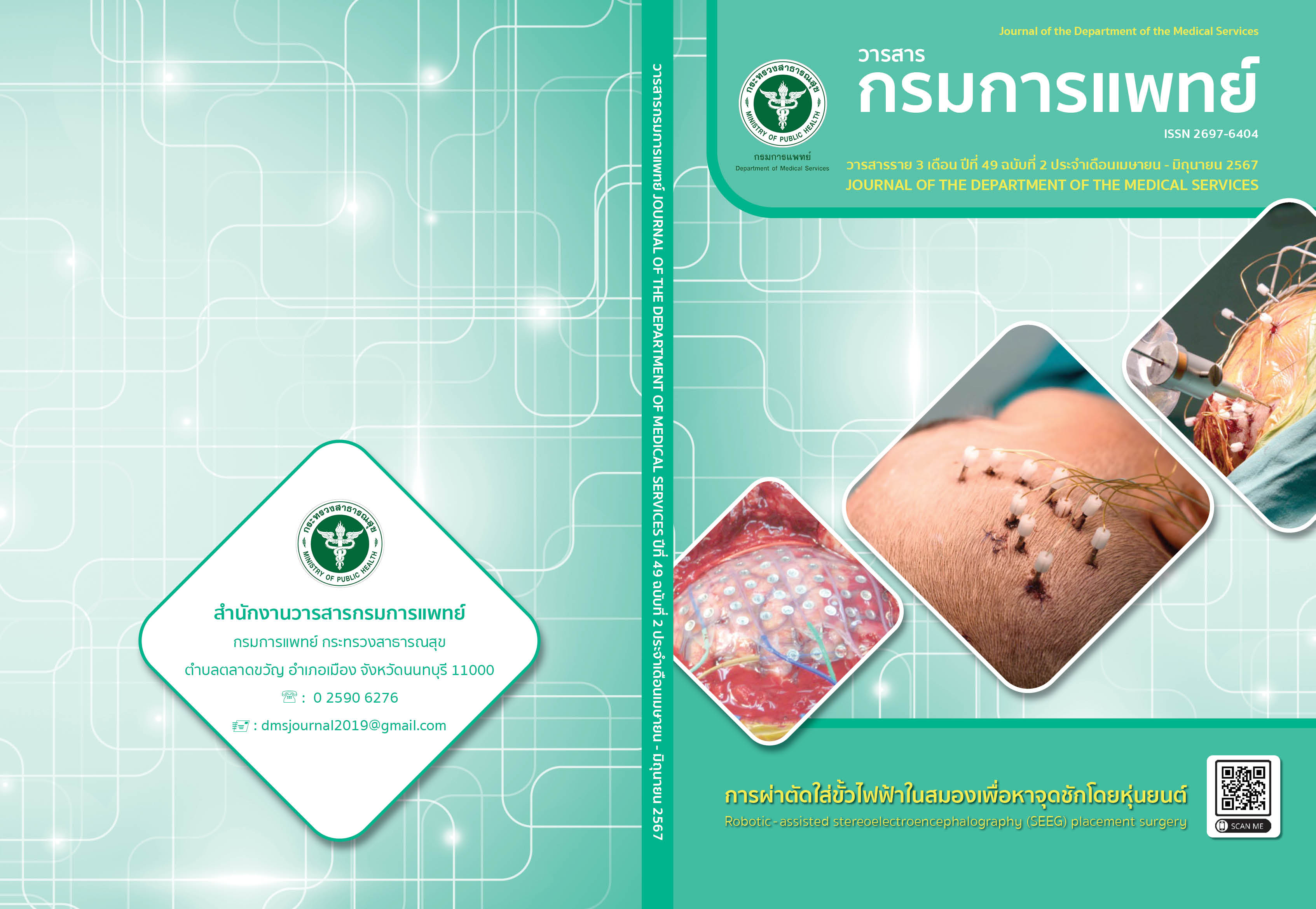Comparison of Outcome in Surgical Treatment of Patients with Metastatic Impending and Pathological Fractures of Proximal Femur: Intramedullary vs. Extra Medullary Fixation
Keywords:
Metastatic bone tumor, Fracture, Fixation, Outcomes of surgery, Comparison of treatmentAbstract
Background: Metastatic bone tumors often result in debilitating fractures of the proximal femur, necessitating surgical intervention to alleviate pain and restore function. While intramedullary and extramedullary fixation techniques are commonly employed, their comparative effectiveness in achieving treatment goals remains uncertain. Objective: The purpose of this study was to compare treatment outcomes of metastatic bone tumor of proximal femur with fracture surgically treated at Rajavithi Hospital, by focusing on patients treated with intramedullary fixation and extramedullary fixation. The Musculoskeletal Tumor Society (MSTS) functional outcome score and post-operative complications between two groups were compared. Methods: Data record of patients with pathological fracture or impending fracture underwent surgery in Rajavithi Hospital. Collected data included baseline and post-operative data. Results: Forty cases of pathological proximal femur fracture or impending fracture were reviewed (18 males and 22 females), patients were categorized into intramedullary fixation (20 cases) and Extramedullary fixation (20 cases). Most recorded type of primary tumor was Breast cancer with a total number of 16 cases. Pathological fracture or impending fractures included 33 cases of intertrochanteric region, 4 cases of sub trochanteric region and 3 cases of proximal femoral shaft region. Mean MSTS score was 23.901.07 in intra- medullary fixation group and 19.70
1.13 in extramedullary fixation group. One case of post-operative wound infection was found in extramedullary fixation group. Conclusion: MSTS functional score was higher and intra-operative blood loss was significantly lesser in Intramedullary fixation group. No significant difference in postoperative complication was found. However, to be able to study more about outcomes, and other complications such as Implant survival and failure rates, higher number of patients and longer follow up period are required.
References
Jasmin C, Coleman RE, Coia LR, Capanna R, Saillant G, Textbook of Bone Metastases. New Jersey: John Wiley & Sons Ltd; 2005. p. 163-84.
Zacherl M, Gruber G, Glehr M, Ofner - Kopeinig P, Radl R, Greitbauer M, et al. Surgery for pathological proximal femoral fractures, excluding femoral head and neck fractures. Int Orthop 2011;35(10):1537-43.
Chang YS, Sung TJ, Metastatic pathologic fractures in lower extremities treated with the locking plate. J Korean Bone Joint Tumor Soc 2010;16(2):80-6.
Shemesh S, Kosashvili Y, Sidon E, Yaari L, Cohen N, Velkes S. Intramedullary nailing without curettage and cement augmentation for the treatment of impending and complete pathological fractures of the proximal or midshaft femur. Acta Orthop Belg 2014; 80(1):144-50.
Hunt KJ, Gollogly S, Randall RL. Surgical fixation of pathologic fractures: an evaluation of evolving treatment methods. Bull Hosp Jt Dis 2006;63(3 - 4):77-82.
Zore Z, Filipović Zore I, Matejcić A, Kamal M, Arslani N, Knezović Zlatarić D. Surgical treatment of pathologic fractures in patients with metastatic tumors. Coll Antropol 2009; 33(4):1383-6.
Steensma M, Boland PJ, Morris CD, Athanasian E, Healey JH. Endoprosthetic treatment is more durable for pathologic proximal femur fractures. Clin Orthop Relat Res 2012;470(3):920-6.
Wedin R, Bauer HC. Surgical treatment of skeletal metastatic lesions of the proximal femur: endoprosthesis or reconstruction nail? J Bone Joint Surg Br 2005;87(12):1653-7.
Hattori H, Mibe J, Matsuoka H, Nagai S, Yamamoto K. Surgical management of metastatic disease of the proximal femur. J Orthop Surg (Hong Kong) 2007;15(3):295-8.
Downloads
Published
How to Cite
Issue
Section
License
Copyright (c) 2024 Department of Medical Services, Ministry of Public Health

This work is licensed under a Creative Commons Attribution-NonCommercial-NoDerivatives 4.0 International License.
บทความที่ได้รับการตีพิมพ์เป็นลิขสิทธิ์ของกรมการแพทย์ กระทรวงสาธารณสุข
ข้อความและข้อคิดเห็นต่างๆ เป็นของผู้เขียนบทความ ไม่ใช่ความเห็นของกองบรรณาธิการหรือของวารสารกรมการแพทย์



